Replication Study of Molded Micro-Textured Samples Made of Ultra-High Molecular Weight Polyethylene for Medical Applications
Abstract
1. Introduction
2. Surface Micro-Texturing for Enhanced Tribological Properties in Bearing Couples
3. Micro-Textures Design
- −
- a pattern of micro-cavities;
- −
- a symmetrical design to avoid anisotropy;
- −
- a cavity area fraction (AF) in the range 10–40%, where AF is defined as the ratio of the cavity area and pattern unit cell area [10].
4. Materials and Methods
5. Characterization of the Mold Surface Micro-Textures
6. Micro-Injection Molding
7. Conclusions
Author Contributions
Funding
Data Availability Statement
Acknowledgments
Conflicts of Interest
References
- Dumbleton, J.H.; Manley, M.T.; Edidin, A.A. A literature review of the association between wear rate and osteolysis in total hip arthroplasty. Arthroplasty 2002, 17, 649–661. [Google Scholar] [CrossRef] [PubMed]
- Eliaz, N. Corrosion of metallic biomaterials: A review. Materials 2019, 12, 407. [Google Scholar] [CrossRef]
- Jamari, J.; Ammarullah, M.I.; Santoso, G.; Sugiharto, S.; Supriyono, T.; Permana, M.S.; Winarni, T.I.; van der Heide, E. Adopted walking condition for computational simulation approach on bearing of hip joint prosthesis: Review over the past 30 years. Heliyon 2022, 8, e12050. [Google Scholar] [CrossRef]
- Fu, J.; Jin, Z.M.; Wang, J.W. UHMWPE Biomaterials for Joint Implants; Springer: Singapore, 2019. [Google Scholar]
- Hussain, M.; Naqvi, R.A.; Abbas, N.; Khan, S.M.; Nawaz, S.; Hussain, A.; Khalid, M.W. Ultra-high-molecular-weight-polyethylene (UHMWPE) as a promising polymer material for biomedical applications: A concise review. Polymers 2020, 12, 323. [Google Scholar] [CrossRef]
- Massimiliano, M.; Affatato, S. Materials for hip prostheses: A review of wear and loading considerations. Materials 2019, 12, 495. [Google Scholar]
- Di Puccio, F.; Mattei, L. Biotribology of artificial hip joints. World J. Orthop. 2015, 6, 77. [Google Scholar] [CrossRef]
- Bracco, P.; Bellare, A.; Bistolfi, A.; Affatato, S. Ultra-High Molecular Weight Polyethylene: Influence of the Chemical, Physical and Mechanical Properties on the Wear Behavior. A Review. Materials 2017, 10, 791. [Google Scholar] [CrossRef]
- Sobieraj, M.C.; Rimnac, C.M. Ultra high molecular weight polyethylene: Mechanics, morphology, and clinical behavior. J. Mech. Behav. Biomed. 2009, 2, 433–443. [Google Scholar] [CrossRef] [PubMed]
- Usami, H.; Sato, T.; Kanda, Y.; Nishio, S. Applicability of interrupted micro cutting process Tilling as surface texturing. In Key Engineering Materials; Trans Tech Publications Ltd.: Wollerau, Switzerland, 2017; Volume 749. [Google Scholar] [CrossRef]
- Pratap, T.; Patra, K. Mechanical micro-texturing of Ti-6Al-4V surfaces for improved wettability and bio-tribological performances. Surf. Coat. Technol. 2018, 349, 71–81. [Google Scholar] [CrossRef]
- Dong, Y.; Svoboda, P.; Vrbka, M.; Kostal, D.; Urban, F.; Cizek, J.; Hartl, M. Towards near-permanent CoCrMo prosthesis surface by combining micro-texturing and low temperature plasma carburising. J. Mech. Behav. Biomed. Mater. 2016, 55, 215–227. [Google Scholar] [CrossRef] [PubMed]
- Jamari, J.; Ammarullah, M.; Saad, A.; Syahrom, A.; Uddin, M.; van der Heide, E.; Basri, H. The effect of bottom profile dimples on the femoral head on wear in metal-on-metal total hip arthroplasty. J. Funct. Biomater. 2021, 12, 38. [Google Scholar] [CrossRef] [PubMed]
- Choudhury, D.; Vrbka, M.; Bin Mamat, A.; Stavness, I.; Roy, C.K.; Mootanah, R.; Krupka, I. The impact of surface and geometry on coefficient of friction of artificial hip joints. J. Mech. Behav. Biomed. Mater. 2017, 72, 192–199. [Google Scholar] [CrossRef] [PubMed]
- Avinash, P.N.; Njuguna, J.; Kandasubramanian, B. UHMWPE for biomedical applications: Performance and functionalization. Eur. Polym. J. 2020, 125, 109529. [Google Scholar]
- Zhang, H.; Liang, Y. Extrusion processing of ultra-high molecular weight polyethylene. Extrus. Met. Polym. Food Prod. 2018, 165–179. [Google Scholar] [CrossRef]
- Galip, Y.; Yang, H.; Turng, L. Injection molding of delamination-free ultra-high-molecular-weight polyethylene. Polym. Eng. Sci. 2019, 59, 2313–2322. [Google Scholar]
- Heidari, B.S.; Davachi, S.M.; Moghaddam, A.H.; Seyfi, J.; Hejazi, I.; Sahraeian, R.; Rashedi, H. Optimization simulated injection molding process for ultrahigh molecular weight polyethylene nanocomposite hip liner using response surface methodology and simulation of mechanical behavior. J. Mech. Behav. Biomed. Mater. 2018, 81, 95–105. [Google Scholar] [CrossRef] [PubMed]
- ánchez-Sánchez, X.; Hernández-Avila, M.; Elizalde, L.; Martínez, O.; Ferrer, I.; Elías-Zuñiga, A. Micro injection molding processing of UHMWPE using ultrasonic vibration energy. Mater. Des. 2017, 132, 1–12. [Google Scholar] [CrossRef]
- Ayad, O.G.; Mourad, A.-H.I.; Greish, Y.E.; Karam, S.M.; Alnaqbi, A.H. Injection-Molded Ultrahigh Molecular Weight Polyethylene Material with Improved Moldability for Artificial Joint Implants Design. Adv. Eng. Mater. 2022, 24, 2200059. [Google Scholar] [CrossRef]
- Yilmaz, G.; Ellingham, T.; Turng, L.-S. Improved Processability and the Processing-Structure-Properties Relationship of Ultra-High Molecular Weight Polyethylene via Supercritical Nitrogen and Carbon Dioxide in Injection Molding. Polymers 2018, 10, 36. [Google Scholar] [CrossRef]
- Ping, L.; Wood, R.J. Tribological performance of surface texturing in mechanical applications-A review. Surf. Topogr. Metrol. Prop. 2020, 8.4, 043001. [Google Scholar]
- Kurtz, S.M. UHMWPE Biomaterials Handbook: Ultra High Molecular Weight Polyethylene in Total Joint Replacement and Medical Devices, 3rd ed.; Elsevier Inc.: Amsterdam, The Netherlands, 2016. [Google Scholar]
- Modica, F.; Basile, V.; Marrocco, V.; Fassi, I. A new process combining micro-electro discharge machining milling and sinking for fast fabrication of microchannels with draft angle. J. Micro Nano-Manuf. 2016, 4, 024501. [Google Scholar] [CrossRef]
- Basile, V.; Modica, F.; Surace, R.; Fassi, I. Micro-texturing of molds via Stereolithography for the fabrication of medical components. Procedia CIRP 2022, 110, 93–98. [Google Scholar] [CrossRef]
- Surace, R.; Bellantone, V.; Trotta, G.; Basile, V.; Modica, F.; Fassi, I. Design and fabrication of a polymeric microfilter for medical applications. J. Micro Nano Manuf. 2016, 4.1, 011006. [Google Scholar] [CrossRef]
- Bellantone, V.; Surace, R.; Modica, F. I Evaluation of mold roughness influence on injected thin micro-cavities. Int. J. Adv. Manuf. Tech. 2018, 94, 4565–4575. [Google Scholar] [CrossRef]
- Surace, R.; Sorgato, M.; Bellantone, V.; Modica, F.; Lucchetta, G.; Fassi, I. Effect of cavity surface roughness and wettability on the filling flow in micro injection molding. J. Manuf. Process. 2019, 43, 105–111. [Google Scholar] [CrossRef]
- Surace, R.; Basile, V.; Bellantone, V.; Modica, F.; Fassi, I. Micro Injection Molding of Thin Cavities Using Stereolithography for Mold Fabrication. Polymers 2021, 13, 1848. [Google Scholar] [CrossRef] [PubMed]
- Kuo, H.C.; Jeng, M.C. The Influence of Injection Molding and Injection Compression Molding on UHMWPE Polymer Microfabrication. Int. Polymer Proc. 2011, 26, 508–516. [Google Scholar] [CrossRef]
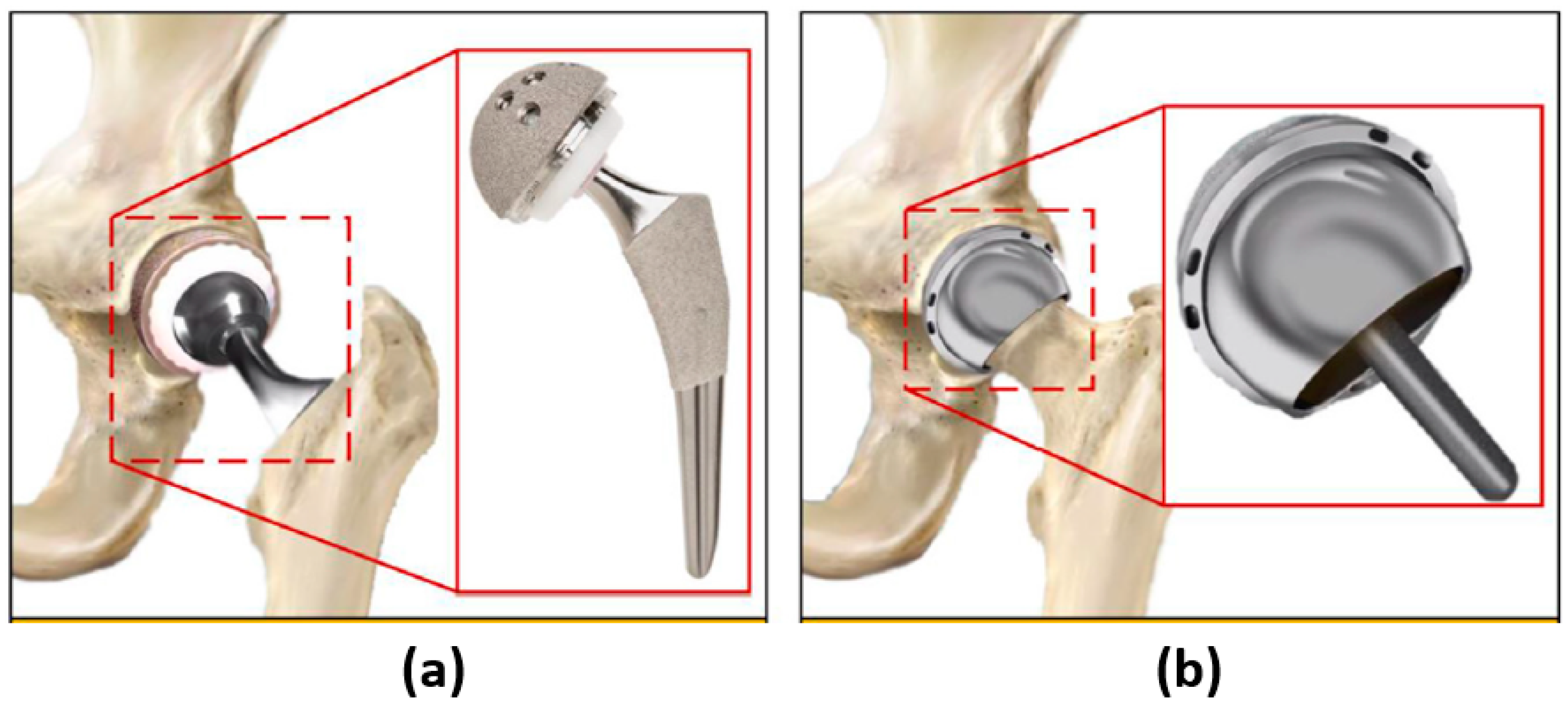


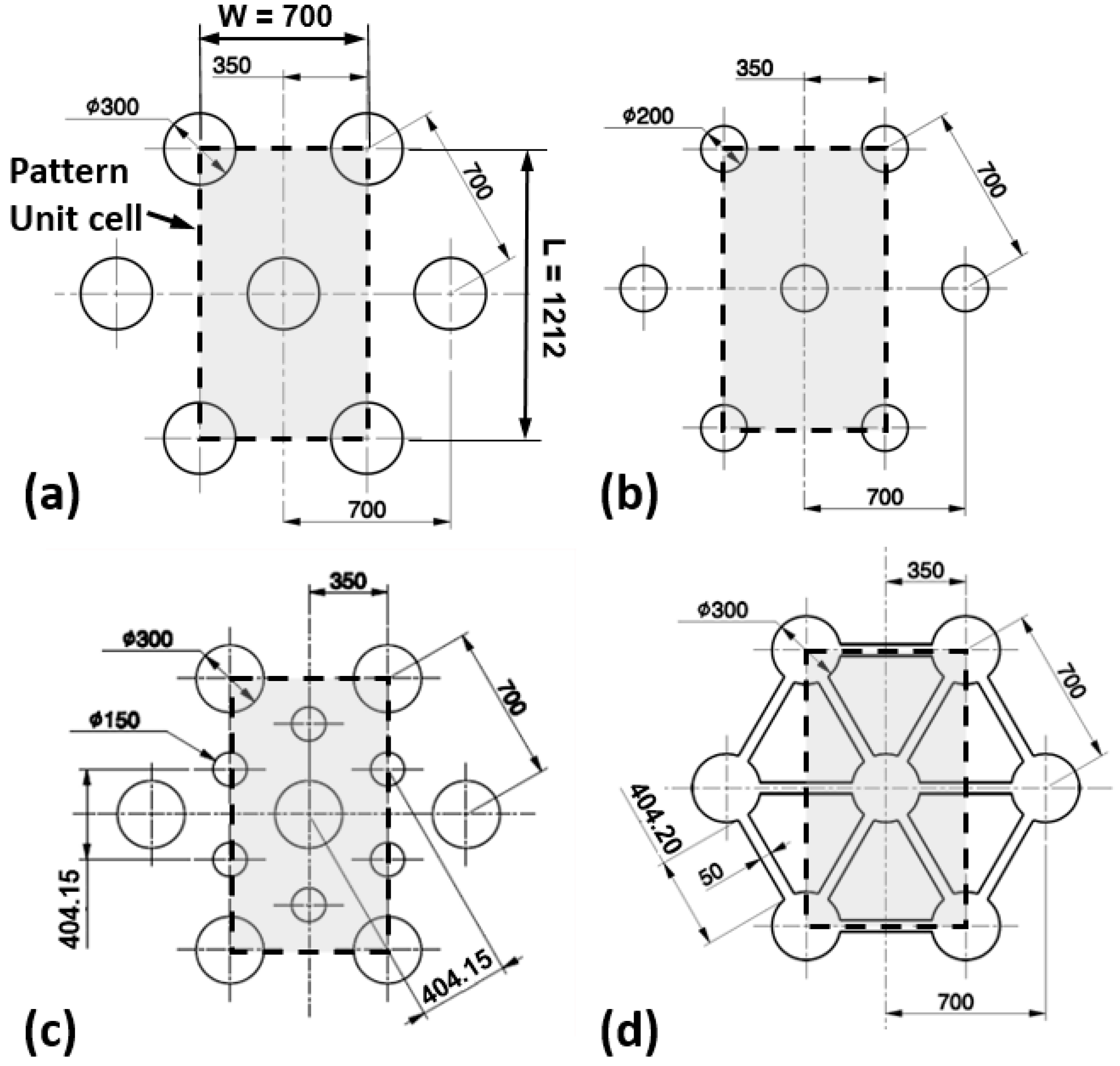
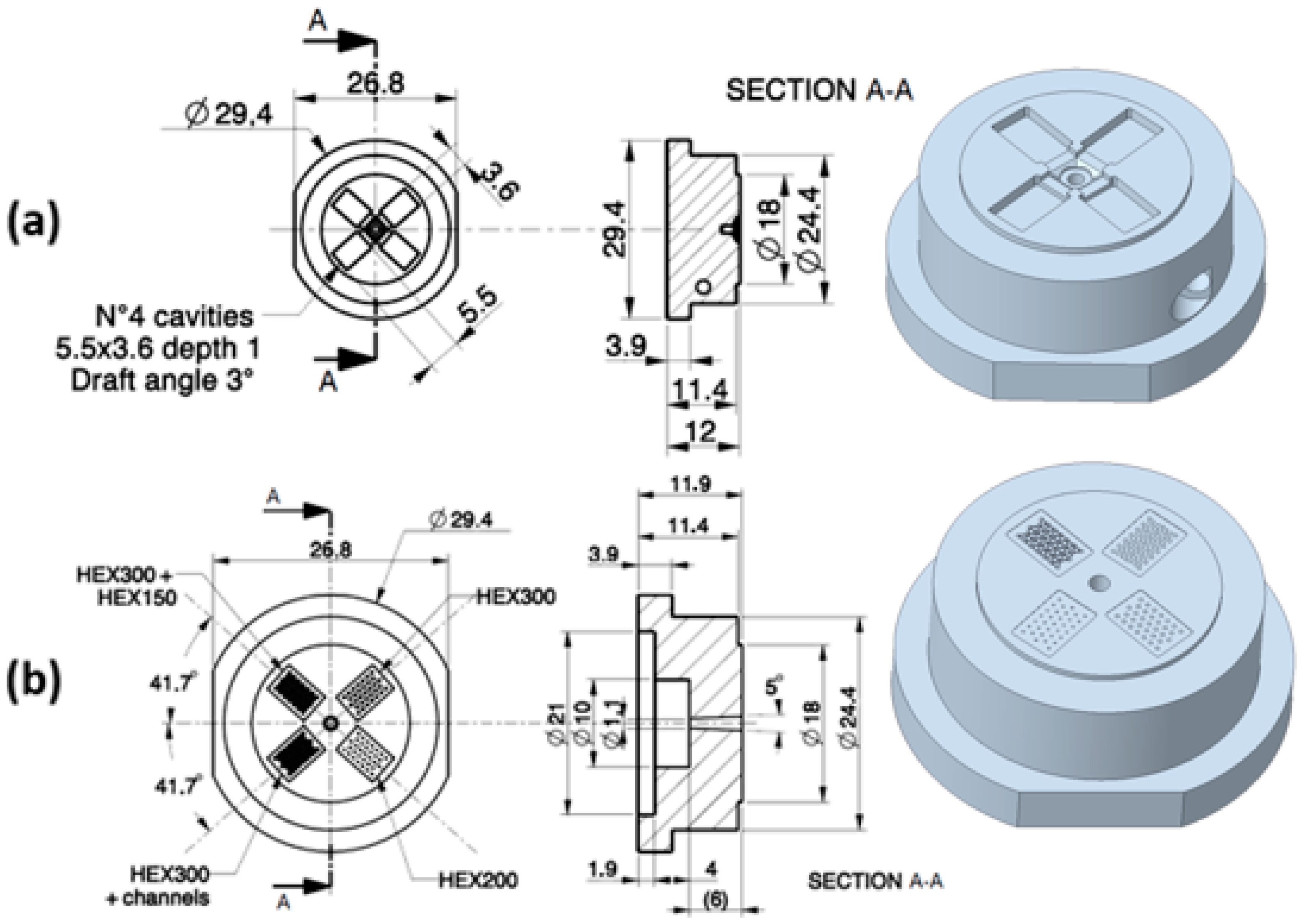
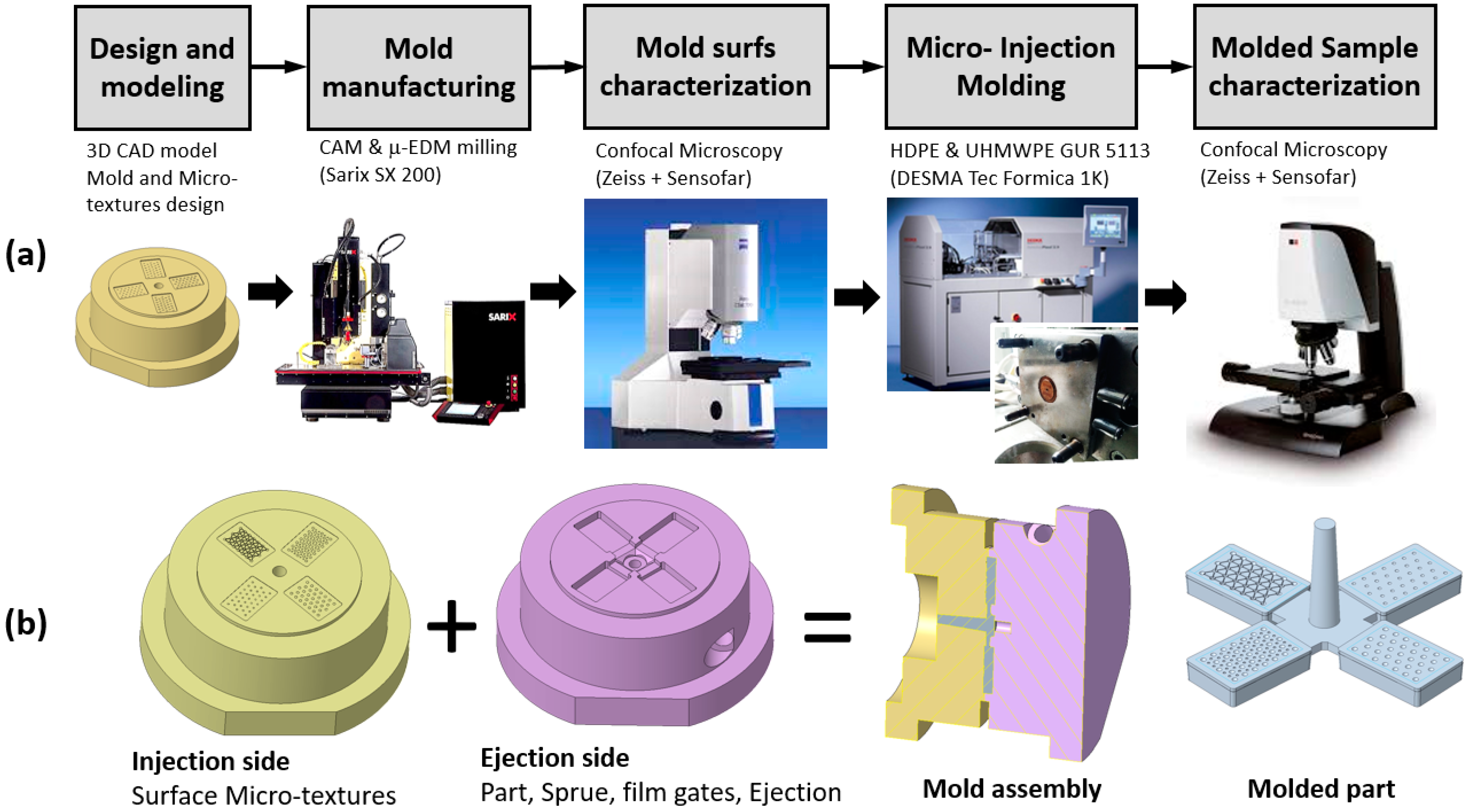
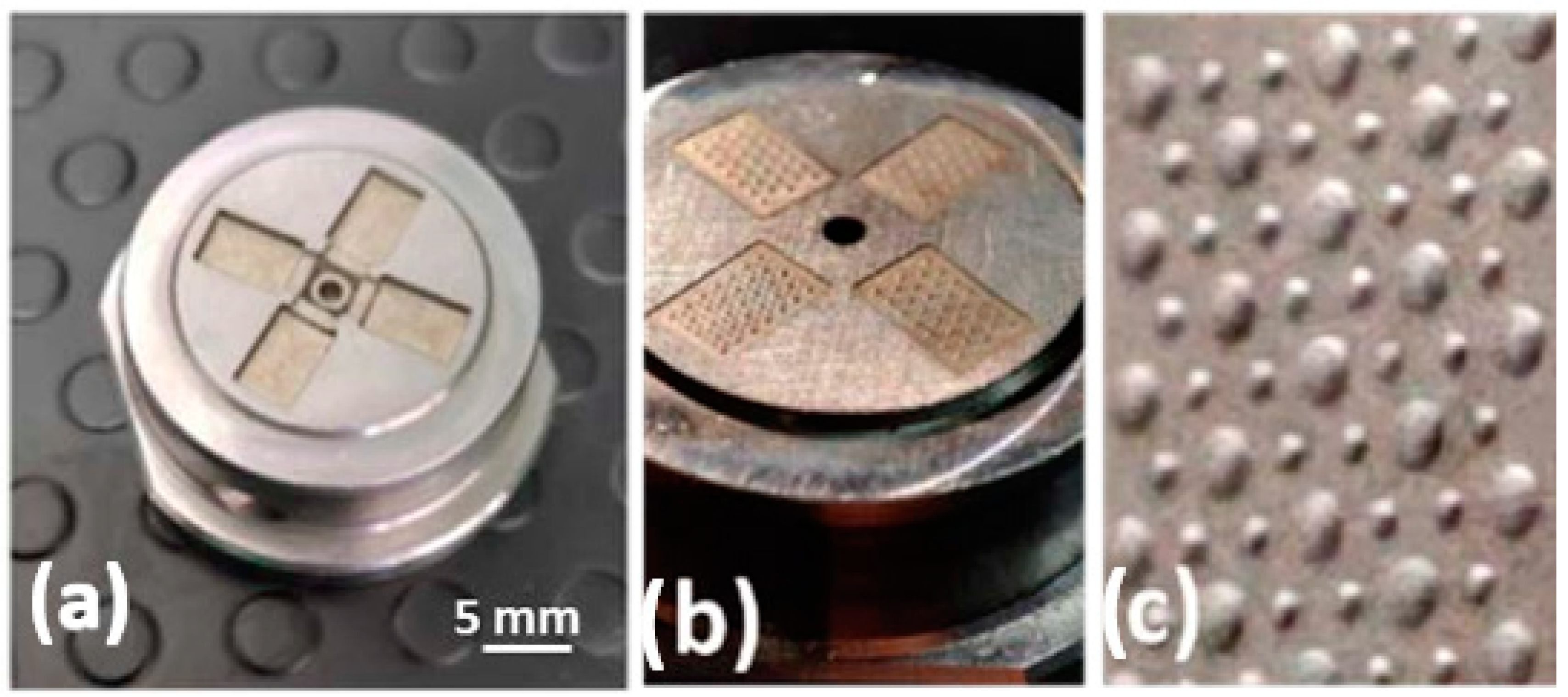
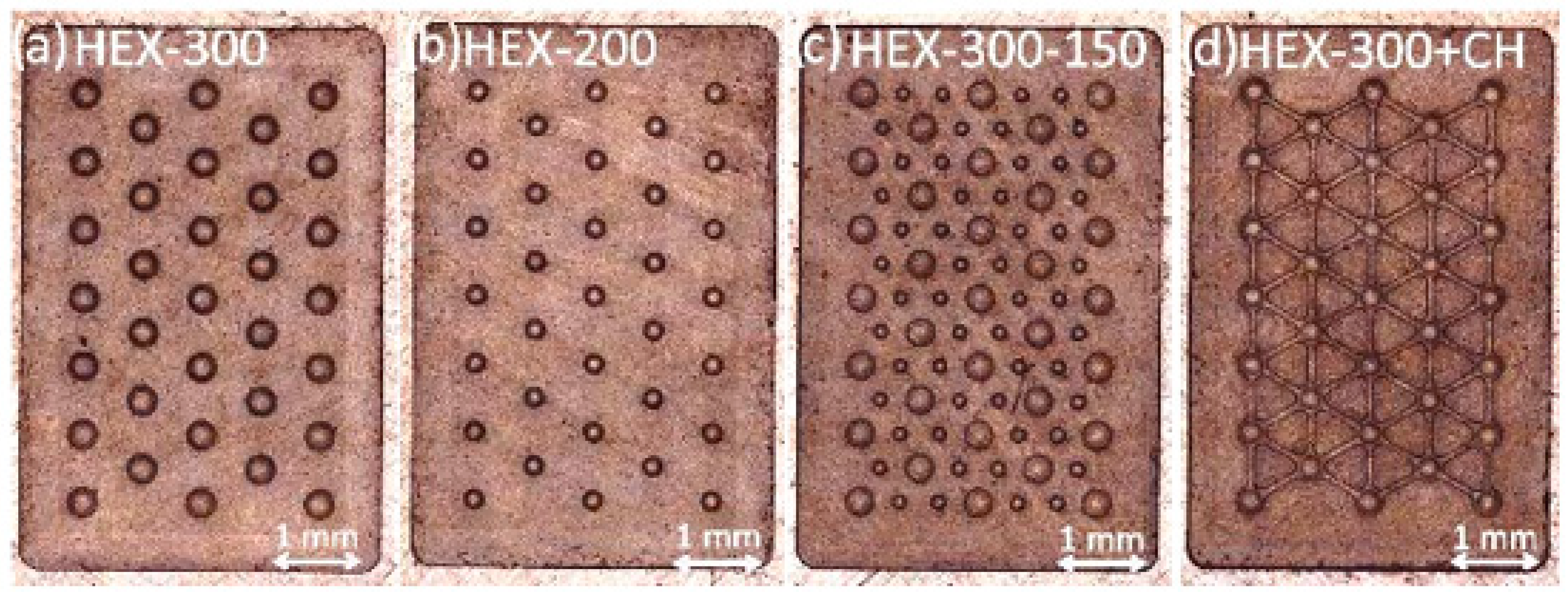
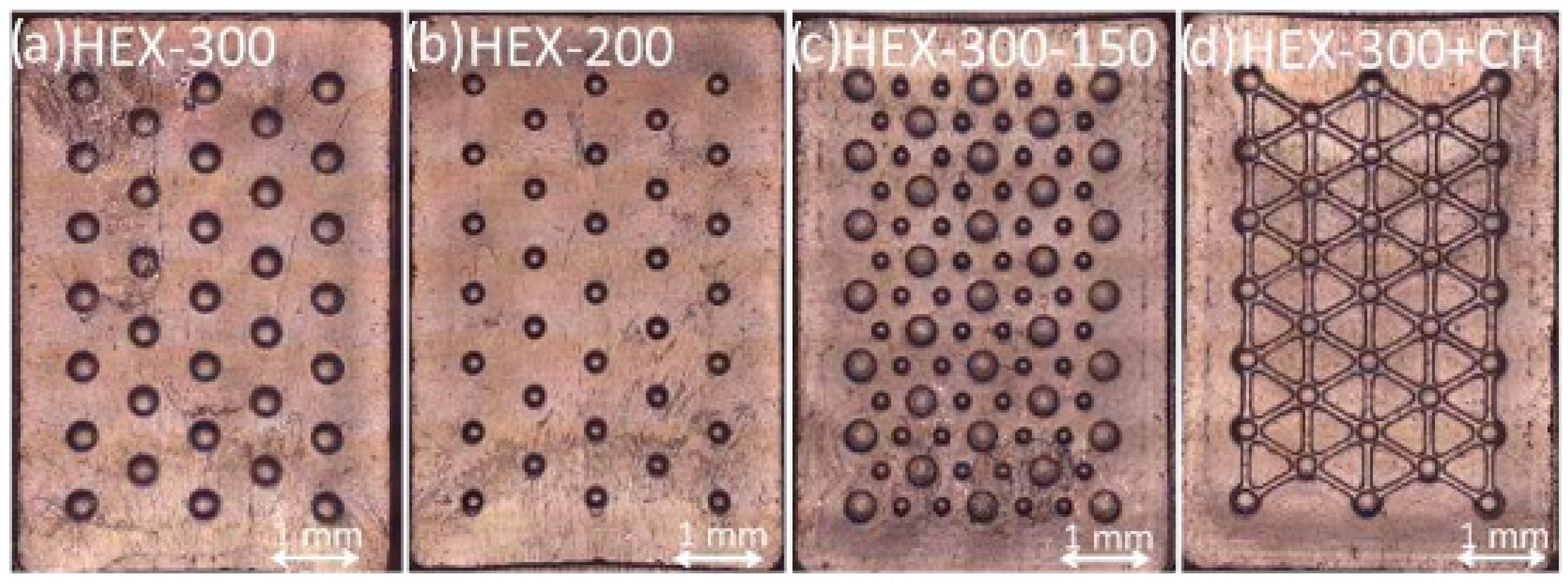

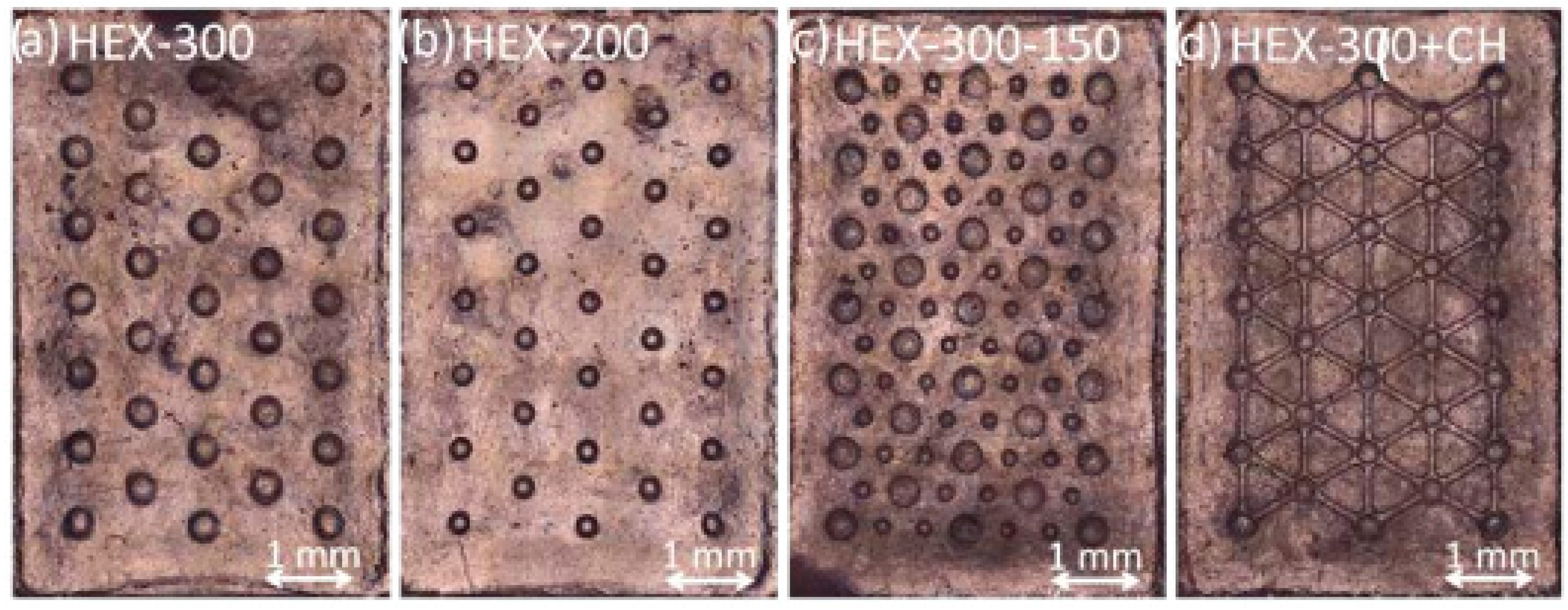
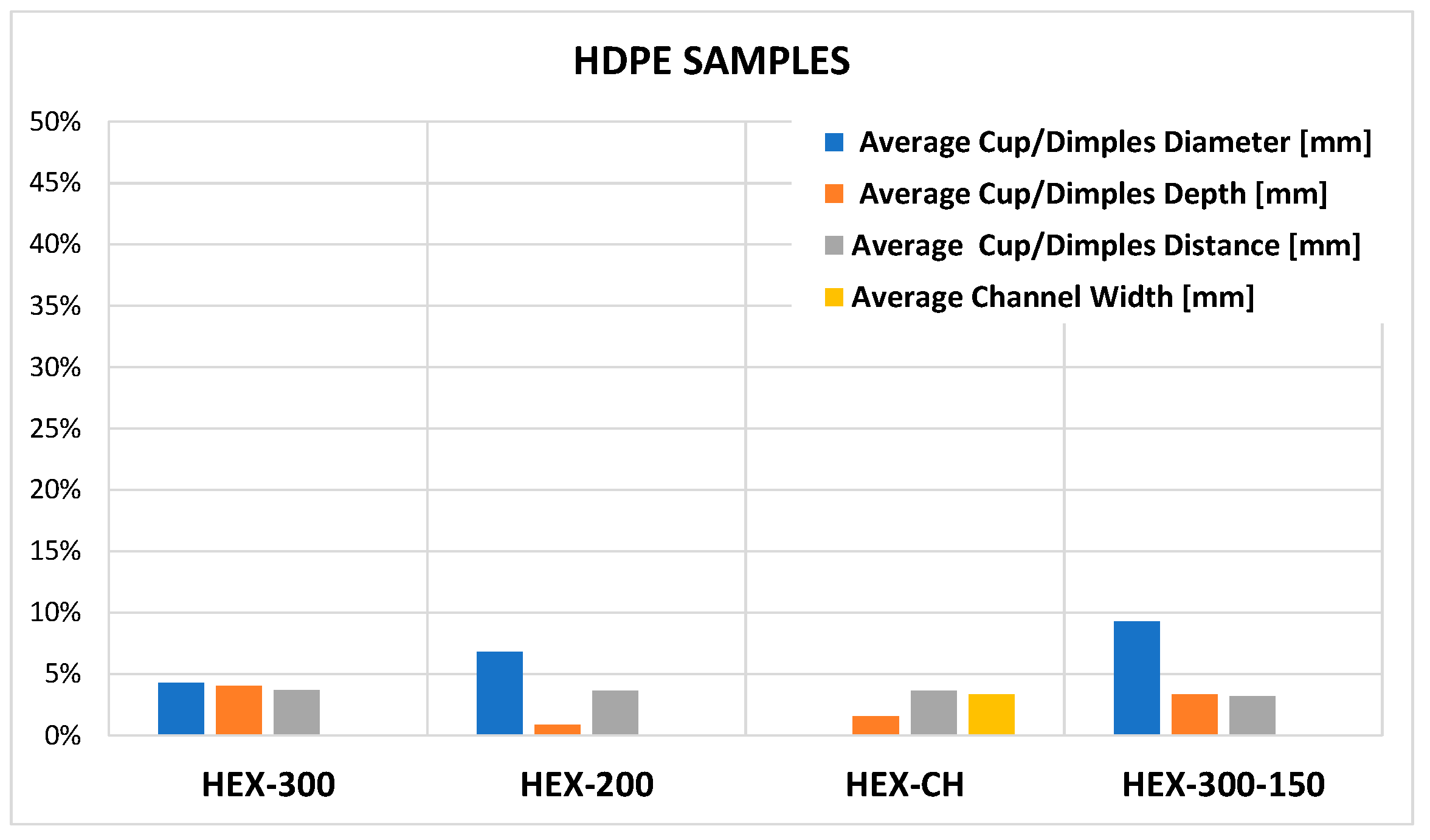
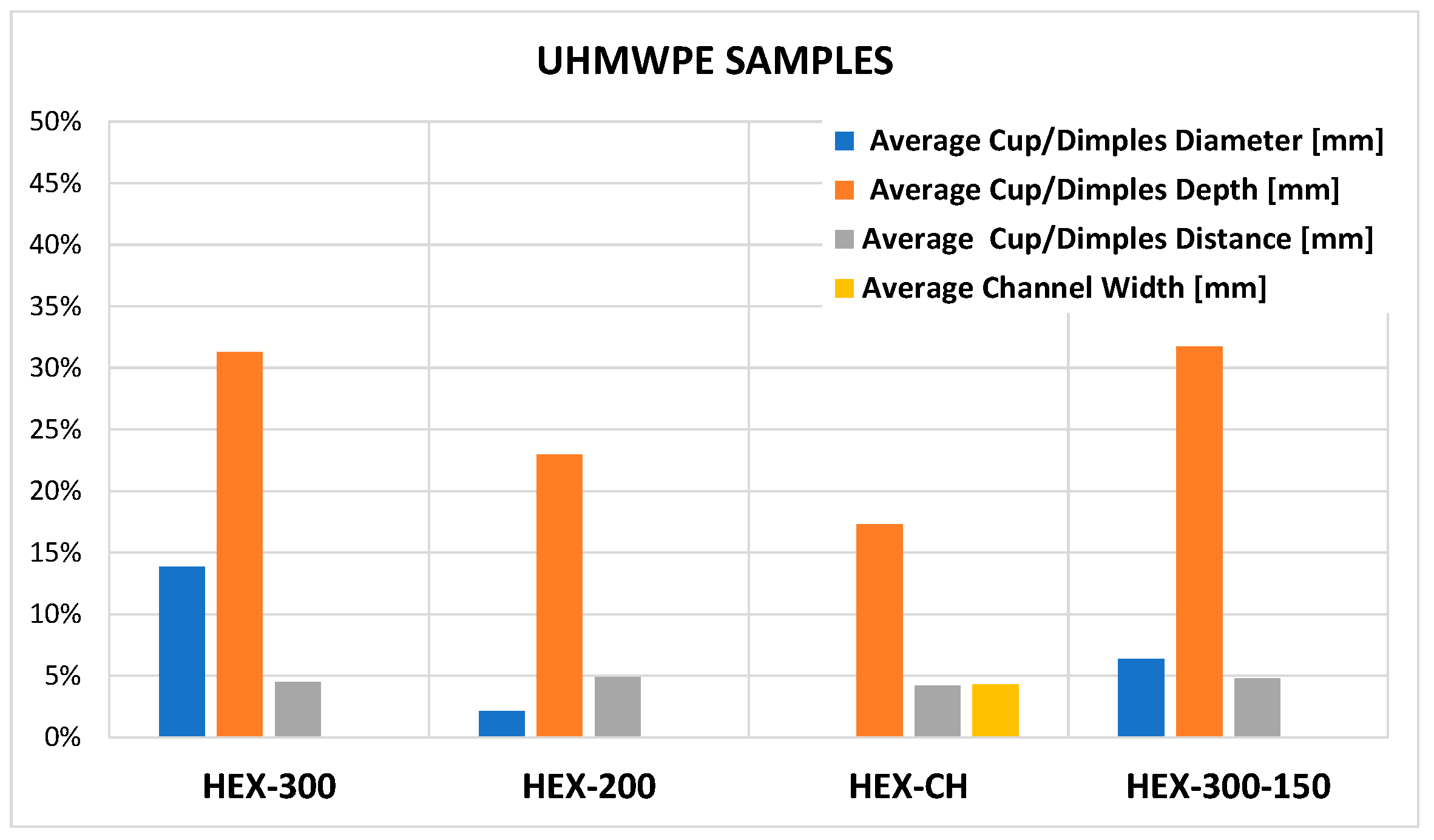
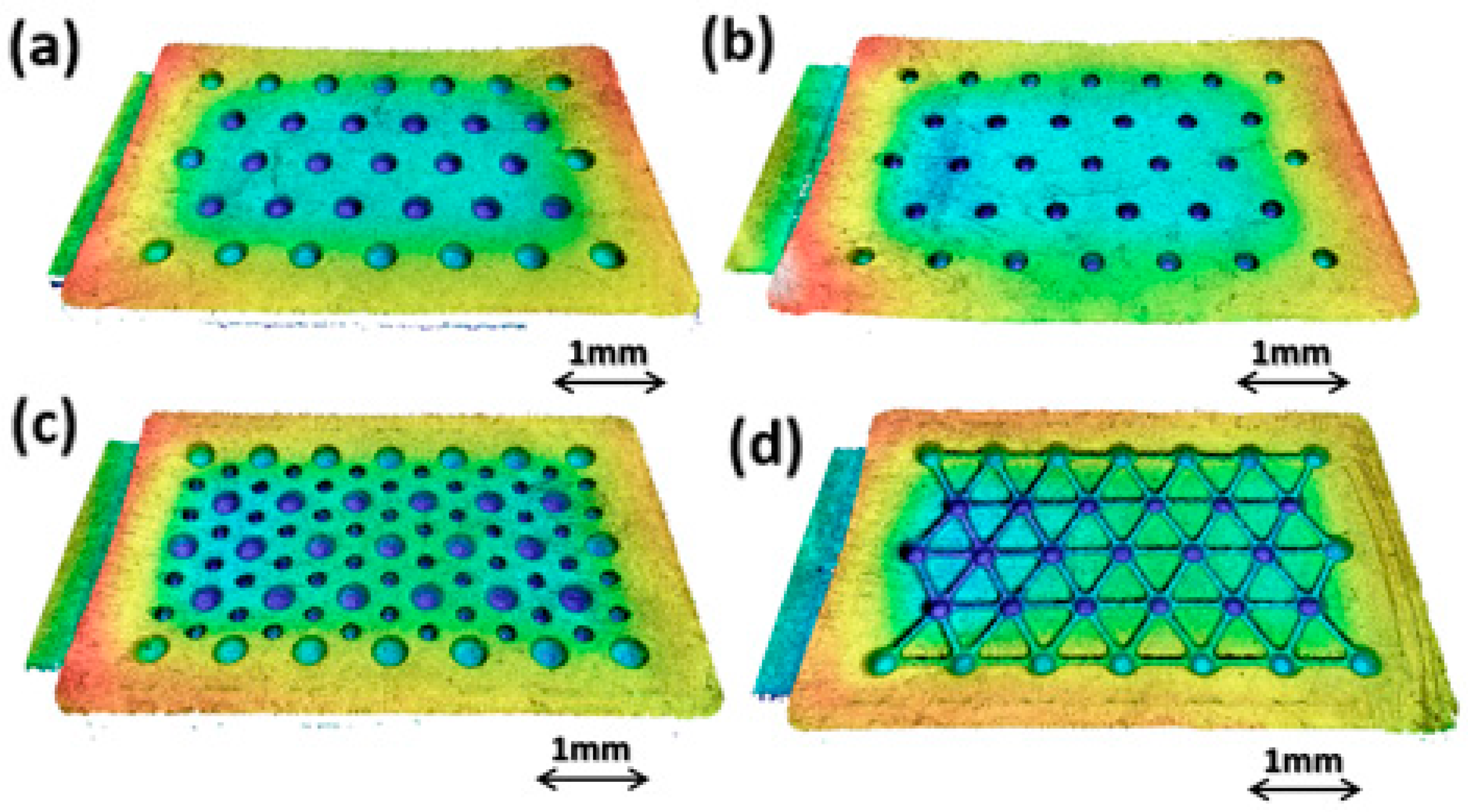
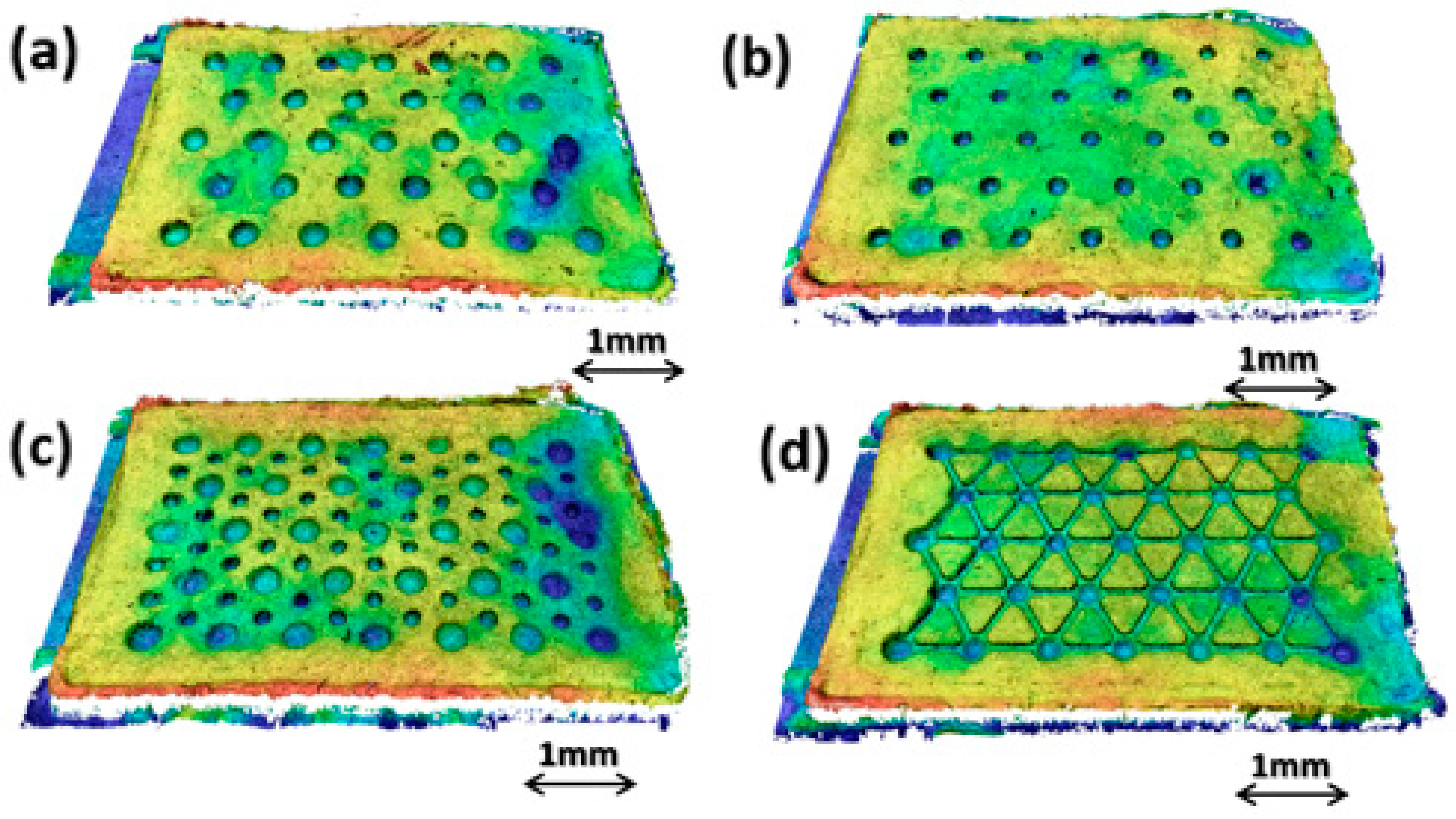
| Micro-texture | Geometrical Parameters (μm) | AF = Cavity Area/Cell Area | Cavity Area Fraction AF% |
|---|---|---|---|
| HEX200 | D = 200; P = 700 | 7.4% | |
| HEX300 | D = 300; P = 700 | 16.7% | |
| HEX300- 150 | D1 = 300; D2 = 150; P1 = 700; P2 = 409.74 | 25.0% | |
| HEX300+CH | D = 300; P = 700; CH = 10; CW = 50; CL = 404.20 | 30.9% |
| Property | Test Method | UHMWPE GUR®5113 | Generic UHMWPE | HDPE Versalis Eraclene MP90C |
|---|---|---|---|---|
| Melting temperature (°C) | ISO 3146-C | 130–135 | 130–135 | 137 |
| Molecular weight (106 g/mol) | ASTM D4001-20 | 3.7 | 3.5–7.5 | 0.05–0.25 |
| Modulus of Elasticity (GPa) | ISO 527 | 0.8 | 0.5–0.8 | 0.4–4.0 |
| Ultimate Tensile Strength (MPa) | ISO 527 | 37 | 39–48 | 17 |
| Degree of crystallinity (%) | DSC 1 | - | 39–75 | 60–80 |
| Wear rate (mm3/106 cycles) | [23] | - | 80–100 | 380–400 |
| Parameter | Units | HEX-300 HEX-200 | HEX-300-150 HEX-CH |
|---|---|---|---|
| Pulse width | (μs) | 4 | 4 |
| Pulse frequency | (Hz) | 160 | 160 |
| Current (Index) | - | 100 | 100 |
| Voltage | (V) | 100 | 100 |
| Gain | - | 220 | 220 |
| Gap | - | 72 | 72 |
| Energy (Index) | - | 100 | 100 |
| Regulation (Index) | - | 4000 | 4000 |
| Incremental depth | (μm) | 0.9 | 1.2 |
| Tool diameter | (mm) | 0.41 | 0.16 |
| Parameter | Unit | HEX-300 | HEX-200 | HEX-CH | HEX-300-150 |
|---|---|---|---|---|---|
| Depth error | (mm) | 0.001 | 0.0006 | 0.0018 | 0.0007 |
| Machining time | (s) | 5965 | 6067 | 5600 | 5697 |
| Average Speed | (mm/s) | 0.62 | 0.62 | 0.60 | 0.63 |
| MRR | (mm3/min) | 0.0086 | 0.0086 | 0.0043 | 0.0045 |
| TWR | - | 0.18 | 0.20 | 1.56 | 1.21 |
| MOLD | HEX-300 | HEX-200 | HEX-300-150 | HEX-CH | |
|---|---|---|---|---|---|
| Domes diameter | |||||
| Nominal (mm) | 0.300 | 0.200 | 0.300 | 0.150 | - |
| Average (mm) | 0.307 | 0.210 | 0.291 | 0.147 | - |
| Mean Deviation (error) (mm) | +0.007 | +0.010 | −0.009 | −0.003 | - |
| std dev (mm) | 0.004 | 0.004 | 0.007 | 0.005 | - |
| Domes height | |||||
| Nominal (mm) | 0.020 | 0.020 | 0.020 | 0.020 | |
| Average (mm) | 0.023 | 0.022 | 0.022 | 0.024 | |
| Mean Deviation (error) (mm) | +0.003 | +0.002 | +0.002 | +0.004 | |
| std dev (mm] | 0.0005 | 0.0006 | 0.0009 | 0.0004 | |
| Domes distance | |||||
| Nominal (mm) | 0.700 | 0.700 | 0.700 | 0.404 | 0.700 |
| Average (mm) | 0.698 | 0.698 | 0.698 | 0.403 | 0.699 |
| Mean Deviation (error) (mm) | −0.002 | −0.002 | −0.002 | −0.001 | −0.001 |
| std dev (mm] | 0.003 | 0.002 | 0.003 | 0.002 | 0.003 |
| Channel Width | |||||
| Nominal (mm) | - | - | - | - | 0.050 |
| Average (mm) | - | - | - | - | 0.054 |
| Mean Deviation (error) (mm) | +0.004 | ||||
| std dev )mm) | - | - | - | - | 0.0026 |
| Surface Roughness Sa (µm) | 0.3 | ||||
| Parameter | Unit | HDPE | UHMWPE |
|---|---|---|---|
| Versalis Eraclene MP90C | Celanese GUR®5113 | ||
| Melt Temperature | (°C) | 200 | 260 |
| Mold Temperature | (°C) | 80 | 100 |
| Injection Speed | (mm/s) | 100 | 230 |
| Holding Pressure | (MPa) | 80 | 150 |
| Holding Time | (s) | 2 | 5 |
| Cooling Time | (s) | 5 | 10 |
| HDPE Samples | HEX-300 | HEX-200 | HEX-300-150 | HEX-CH | |
|---|---|---|---|---|---|
| Cups Diameter | - | ||||
| Nominal (mm) | 0.300 | 0.200 | 0.300 | 0.150 | - |
| Mold feature (mm) | 0.307 | 0.210 | 0.291 | 0.147 | - |
| Sample Average (mm) | 0.294 | 0.224 | 0.301 | 0.169 | - |
| Mean Deviation(error) (mm) | −0.013 | 0.014 | 0.01 | 0.022 | - |
| std dev (mm) | 0.029 | 0.025 | 0.010 | 0.007 | - |
| Cups Depth | |||||
| Nominal (mm) | 0.020 | 0.020 | 0.020 | 0.020 | |
| Mold feature (mm) | 0.023 | 0.022 | 0.022 | 0.024 | |
| Sample Average (mm) | 0.024 | 0.022 | 0.023 | 0.024 | |
| Mean Deviation (error) (mm) | 0.001 | 0.000 | 0.001 | 0.000 | |
| std dev (mm) | 0.0024 | 0.0014 | 0.0014 | 0.0018 | |
| Cups Distance | |||||
| Nominal (mm) | 0.700 | 0.700 | 0.700 | 0.404 | 0.700 |
| Mold feature (mm) | 0.698 | 0.698 | 0.698 | 0.403 | 0.699 |
| Sample Average (mm) | 0.672 | 0.673 | 0.675 | 0.390 | 0.673 |
| Mean Deviation (error) (mm) | −0.028 | −0.027 | −0.025 | −0.014 | −0.027 |
| std dev (mm) | 0.007 | 0.009 | 0.003 | 0.002 | 0.004 |
| Channels Width | |||||
| Nominal (mm) | - | - | - | - | 0.050 |
| Mold feature (mm) | - | - | - | - | 0.054 |
| Sample Average (mm) | - | - | - | - | 0.052 |
| Mean Deviation (error) (mm) | - | - | - | - | −0.002 |
| std dev (mm) | - | - | - | - | 0.0012 |
| Surface Roughness Sa (µm) | 0.3 | ||||
| UHMWPE Samples | HEX-300 | HEX-200 | HEX-300-150 | HEX-CH | |
|---|---|---|---|---|---|
| Cups Diameter | |||||
| Nominal (mm) | 0.300 | 0.200 | 0.300 | 0.150 | - |
| Mold feature (mm) | 0.307 | 0.210 | 0.291 | 0.147 | - |
| Sample Average (mm) | 0.265 | 0.205 | 0.265 | 0.141 | - |
| Mean Deviation (error) (mm) | −0.042 | −0.005 | −0.026 | −0.006 | - |
| std dev (mm) | 0.017 | 0.004 | 0.017 | 0.005 | - |
| Cups Depth | |||||
| Nominal (mm) | 0.020 | 0.020 | 0.020 | 0.020 | |
| Mold feature (mm) | 0.023 | 0.022 | 0.022 | 0.024 | |
| Sample Average (mm) | 0.03 | 0.028 | 0.029 | 0.028 | |
| Mean Deviation (error) (mm) | 0.007 | 0.006 | 0.007 | 0.004 | |
| std dev (mm) | 0.0019 | 0.0015 | 0.0028 | 0.0006 | |
| Cups Distance | |||||
| Nominal (mm) | 0.700 | 0.700 | 0.700 | 0.404 | 0.700 |
| Mold feature (mm) | 0.698 | 0.698 | 0.698 | 0.403 | 0.699 |
| Sample Average (mm) | 0.667 | 0.664 | 0.667 | 0.382 | 0.669 |
| Mean Deviation (error) (mm) | −0.031 | −0.034 | −0.031 | −0.021 | −0.030 |
| std dev (mm) | 0.017 | 0.006 | 0.017 | 0.006 | 0.011 |
| Channels Width | |||||
| Nominal (mm) | - | - | - | - | 0.050 |
| Mold feature (mm) | - | - | - | - | 0.054 |
| Sample Average (mm) | - | - | - | - | 0.051 |
| Mean Deviation (error) (mm) | - | - | - | - | −0.003 |
| std dev (mm) | - | - | - | - | 0.0030 |
| Surface Roughness Sa (µm) | 0.2 | ||||
Disclaimer/Publisher’s Note: The statements, opinions and data contained in all publications are solely those of the individual author(s) and contributor(s) and not of MDPI and/or the editor(s). MDPI and/or the editor(s) disclaim responsibility for any injury to people or property resulting from any ideas, methods, instructions or products referred to in the content. |
© 2023 by the authors. Licensee MDPI, Basel, Switzerland. This article is an open access article distributed under the terms and conditions of the Creative Commons Attribution (CC BY) license (https://creativecommons.org/licenses/by/4.0/).
Share and Cite
Modica, F.; Basile, V.; Surace, R.; Fassi, I. Replication Study of Molded Micro-Textured Samples Made of Ultra-High Molecular Weight Polyethylene for Medical Applications. Micromachines 2023, 14, 523. https://doi.org/10.3390/mi14030523
Modica F, Basile V, Surace R, Fassi I. Replication Study of Molded Micro-Textured Samples Made of Ultra-High Molecular Weight Polyethylene for Medical Applications. Micromachines. 2023; 14(3):523. https://doi.org/10.3390/mi14030523
Chicago/Turabian StyleModica, Francesco, Vito Basile, Rossella Surace, and Irene Fassi. 2023. "Replication Study of Molded Micro-Textured Samples Made of Ultra-High Molecular Weight Polyethylene for Medical Applications" Micromachines 14, no. 3: 523. https://doi.org/10.3390/mi14030523
APA StyleModica, F., Basile, V., Surace, R., & Fassi, I. (2023). Replication Study of Molded Micro-Textured Samples Made of Ultra-High Molecular Weight Polyethylene for Medical Applications. Micromachines, 14(3), 523. https://doi.org/10.3390/mi14030523












